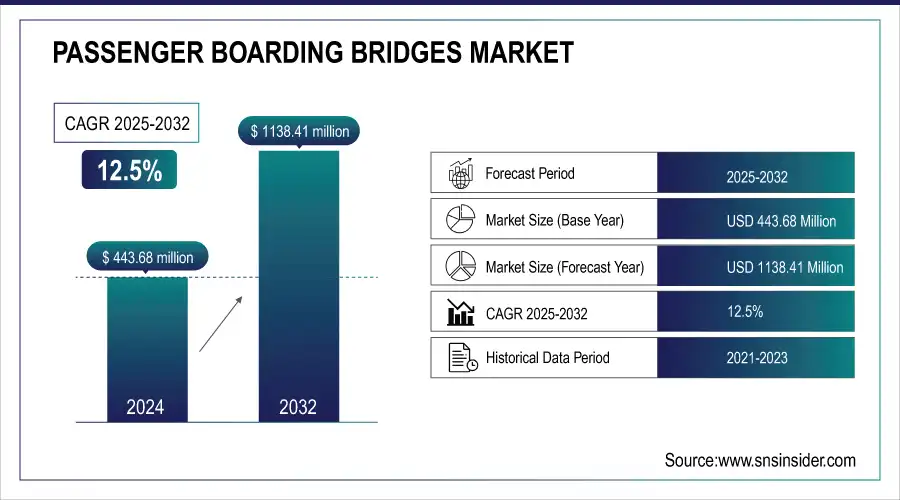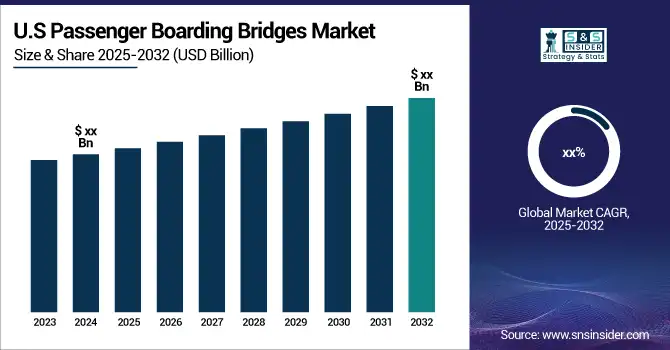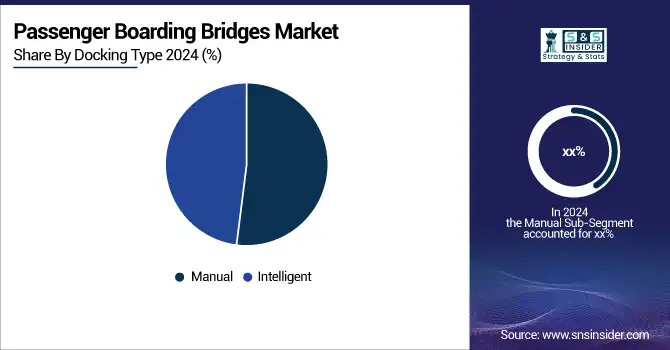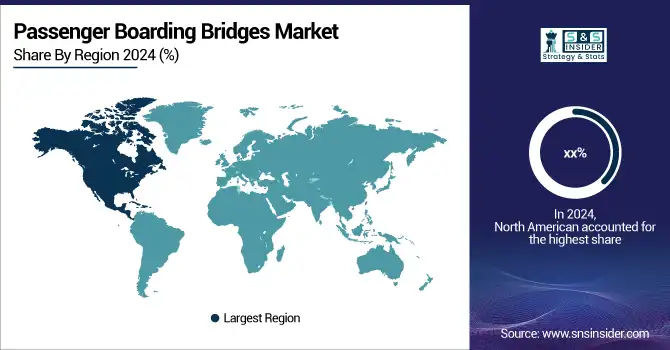Passenger Boarding Bridges Market Report Scope & Overview:
The Passenger Boarding Bridges Market Size was valued at USD 443.68 million in 2024 and is expected to reach USD 1138.41 million by 2032 with a growing CAGR of 12.5% over the forecast period 2025-2032.
Passenger boarding bridges have been a typical fixture at international airports for decades. An air, jet, or sky bridge is another name for a passenger airport boarding bridge. Because passengers are not exposed to the airport's weather and noise, boarding corridors are designed to transport passengers/passengers comfortably and safely to planes. Because the passenger boarding bridges are an extension of the airport's terminal, they are intimately linked to the terminal's mood and design. It also improves safety by giving passengers with a protected and safe passage from the terminal's embarkation port to their seats on flights.

To get more information on Passenger Boarding Bridges Market - Request Free Sample Report
Increased passenger traffic, renovation and upgrading of ageing facilities, expansion of current terminals, and the construction of new airports drive worldwide passenger boarding demand. Growing passenger volume and the aircraft's quick turnaround time put airports under pressure to create better infrastructure, such as upgraded passenger boarding bridges. Increasing worries about airport security, e-passport implementation, and the need for more aircraft ground support infrastructure, together with a fast developing aviation business, have driven investment efforts while opening the path for improved infrastructure expansion. Nonetheless, accidents have occurred that have jeopardized passenger and aircraft safety due to insufficient training or operational flaws in the sensors deployed on passenger boarding bridges. It has caused damage to both aircraft and airport infrastructure, as well as passenger disruption. Passenger services and raised safety concerns.

Key Passenger Boarding Bridges Market Trends:
• Rising global air travel and increasing passenger volumes driving demand for efficient boarding solutions.
• High demand for large aircraft requiring modern, adaptable passenger boarding bridges.
• Expansion and modernization of airports to accommodate growing airline operations.
• Focus on enhancing passenger safety, comfort, and turnaround times through advanced PBB technology.
• Adoption of innovative financing models, such as public-private partnerships, facilitating large-scale infrastructure development.
Passenger Boarding Bridges Market Growth Drivers:
The Passenger Boarding Bridges market is benefiting from high demand for large aircraft as global passenger travel grows, despite rising fuel costs and economic slowdowns. Increased airline operations and airport expansions are driving the need for efficient boarding solutions. Modern PBBs enhance passenger safety, comfort, and turnaround times, supporting airports and airlines in managing higher passenger volumes effectively.
Passenger Boarding Bridges Market Restraints:
A key restraint in the Passenger Boarding Bridges market is their long life cycle, which limits frequent upgrades. Additionally, the process of ordering, procuring, and installing PBBs is time-consuming, delaying deployment and reducing flexibility for airports to quickly adapt to changing passenger volumes or implement the latest technological advancements.
Passenger Boarding Bridges Market Opportunities:
Opportunities in the Passenger Boarding Bridges market include public-private partnerships (PPPs) for air-side operations. These collaborations enable innovative financing and efficient execution of large infrastructure projects, engaging key stakeholders to enhance airport capacity, modernize boarding systems, and improve operational efficiency while sharing investment risks and benefits between public authorities and commercial entities.
Passenger Boarding Bridges Market Segment Analysis:
By Docking Type
In 2024, manual docking systems dominate the Passenger Boarding Bridges market due to their simplicity, reliability, and cost-effectiveness, making them widely adopted across airports. Looking ahead, intelligent docking systems are expected to grow fastest from 2025 to 2032, driven by automation and AI integration. These advanced systems improve operational efficiency, precision, and passenger experience, enabling airports to handle higher traffic volumes and streamline aircraft boarding processes with enhanced safety and accuracy.

By Foundation
In 2024, fixed foundations dominate the Passenger Boarding Bridges market due to their stability and suitability for established airport infrastructures. From 2025 to 2032, movable foundations are expected to grow fastest, offering enhanced flexibility to serve multiple aircraft types and adapt to evolving airport layouts. This adaptability supports efficient operations, optimizes gate utilization, and meets the increasing demand for versatile boarding solutions in expanding and modernizing airports worldwide.
By Elevation System
In 2024, hydraulic elevation systems dominate the Passenger Boarding Bridges market because of their reliability and proven technology. From 2025 to 2032, electro-mechanical systems are expected to grow fastest, driven by energy efficiency, lower maintenance requirements, and compatibility with sustainable airport operations, making them an increasingly preferred choice for modern airports seeking cost-effective and environmentally friendly boarding solutions.
By Tunnel Type
In 2024, air-conditioned tunnels dominate the Passenger Boarding Bridges market, ensuring passenger comfort across diverse climates. From 2025 to 2032, un-air-conditioned tunnels are expected to grow fastest, particularly in regions with milder weather. These tunnels offer significant cost savings and energy efficiency, making them an attractive option for airports aiming to optimize operational expenses while maintaining adequate passenger convenience.
By Product Type
In 2024, Apron Drive bridges dominate the Passenger Boarding Bridges market due to their versatility and capability to serve a wide range of aircraft. From 2025 to 2032, over-the-wing bridges are expected to grow fastest, especially in airports with space constraints, providing efficient boarding for larger aircraft with multiple doors and supporting optimized gate utilization.
Passenger Boarding Bridges Market Regional Analysis:
North America Passenger Boarding Bridges Market Insights:
North America leads the market due to well-developed airport infrastructure, high air travel demand, and adoption of advanced PBB technologies. Expansion of major airports, modernization initiatives, and strong airline operations drive the need for efficient boarding solutions, supporting passenger safety, comfort, and faster aircraft turnaround times.

Need any customization research on Passenger Boarding Bridges Market - Enquiry Now
Asia Pacific Passenger Boarding Bridges Market Insights:
Asia Pacific shows strong growth driven by increasing air passenger traffic, airport expansion projects, and rising investments in digital and automated PBB systems. Rapid urbanization, growing low-cost carriers, and government initiatives to modernize airports boost demand for advanced boarding solutions across the region.
Europe Passenger Boarding Bridges Market Insights:
Europe’s PBB market is driven by modernization of airports, stringent safety regulations, and technological advancements. High passenger volumes, growing tourism, and adoption of intelligent docking and electro-mechanical systems support market expansion, enabling efficient boarding, enhanced passenger experience, and optimized operational efficiency.
Latin America (LATAM) & Middle East & Africa (MEA) Passenger Boarding Bridges Market Insights:
The LATAM and MEA PBB market is expanding with increasing airport infrastructure development, rising air travel, and government support. Adoption of flexible, cost-effective, and energy-efficient boarding solutions, including movable and un-air-conditioned bridges, drives growth in emerging markets with evolving aviation sectors.
Passenger Boarding Bridges Market Key Players:
-
Ameribridge, Inc.
-
Adele Group
-
CIMC Group Ltd.
-
John Bean Technologies Corp. (JBT)
-
ThyssenKrupp AG
-
UBS Airport Systems
-
Vataple Group Ltd.
-
Mitsubishi Heavy Industries
-
ShinMaywa Industries Ltd.
-
FMT Sweden AB
-
Oshkosh Corporation
-
HÜBNER GmbH & Co. KG
-
Accessair Systems Inc.
-
AviaSafe GmbH
-
Jiangsu Tianyi Aviation Industry Co., Ltd.
-
J&D McLennan Ltd.
-
PT Bukaka Teknik Utama Tbk
-
Aviramp Ltd.
-
Hubner GmbH & Co. KG
-
TK Airport Solutions S.A.
Competitive Landscape for Passenger Boarding Bridges Market:
CIMC Group Ltd., through its subsidiary CIMC Tianda, is a global leader in the Passenger Boarding Bridges (PBB) market. With over 7,500 PBBs installed across more than 345 airports in 75 countries, it holds a dominant position in both the Chinese and European markets. The company is recognized for its innovative solutions, including the development of the world's first unmanned intelligent jet bridge, enhancing operational efficiency and reducing boarding times. CIMC Tianda's commitment to quality and technological advancement solidifies its status as a key player in the global airport infrastructure sector.
- CIMC-TianDa delivered 184 passenger boarding bridges to Paris Charles de Gaulle and Orly airports to facilitate efficient passenger movement during the Summer Olympics. The company has installed over 10,000 boarding bridges at 419 airports in 89 countries
| Report Attributes | Details |
| Market Size in 2024 | USD 443.68 Million |
| Market Size by 2032 | USD 1138.41 Million |
| CAGR | CAGR of 12.5% From 2024 to 2032 |
| Base Year | 2024 |
| Forecast Period | 2025-2032 |
| Historical Data | 2021-2023 |
| Report Scope & Coverage | Market Size, Segments Analysis, Competitive Landscape, Regional Analysis, DROC & SWOT Analysis, Forecast Outlook |
| Key Segments | • By Docking Type (Manual, Intelligent) • By Foundation(Fixed, Movable) • By Elevation System (Hydraulic, Electro-mechanical) • By Tunnel Type (Air-conditioned, UN-air-conditioned) • By Product Type (Apron Drive, Commuter Bridges, Nose-loader bridges, T-bridges, Over-the-wing Bridges) |
| Regional Analysis/Coverage | North America (US, Canada), Europe (Germany, UK, France, Italy, Spain, Russia, Poland, Rest of Europe), Asia Pacific (China, India, Japan, South Korea, Australia, ASEAN Countries, Rest of Asia Pacific), Middle East & Africa (UAE, Saudi Arabia, Qatar, South Africa, Rest of Middle East & Africa), Latin America (Brazil, Argentina, Mexico, Colombia, Rest of Latin America). |
| Company Profiles | Ameribridge, Inc., Adelte Group, CIMC Group Ltd., John Bean Technologies Corp., ThyssenKrupp AG, UBS Airport Systems, Vataple Group Ltd, Mitsubishi Heavy Industries, ShinMaywa Industries Ltd, FMT Sweden AB, Oshkosh Corporation, HÜBNER GmbH & Co. KG, Accessair Systems Inc., AviaSafe GmbH, Jiangsu Tianyi Aviation Industry Co., Ltd., J&D McLennan Ltd., PT Bukaka Teknik Utama Tbk, Aviramp Ltd., Hubner GmbH & Co. KG, TK Airport Solutions S.A. |

